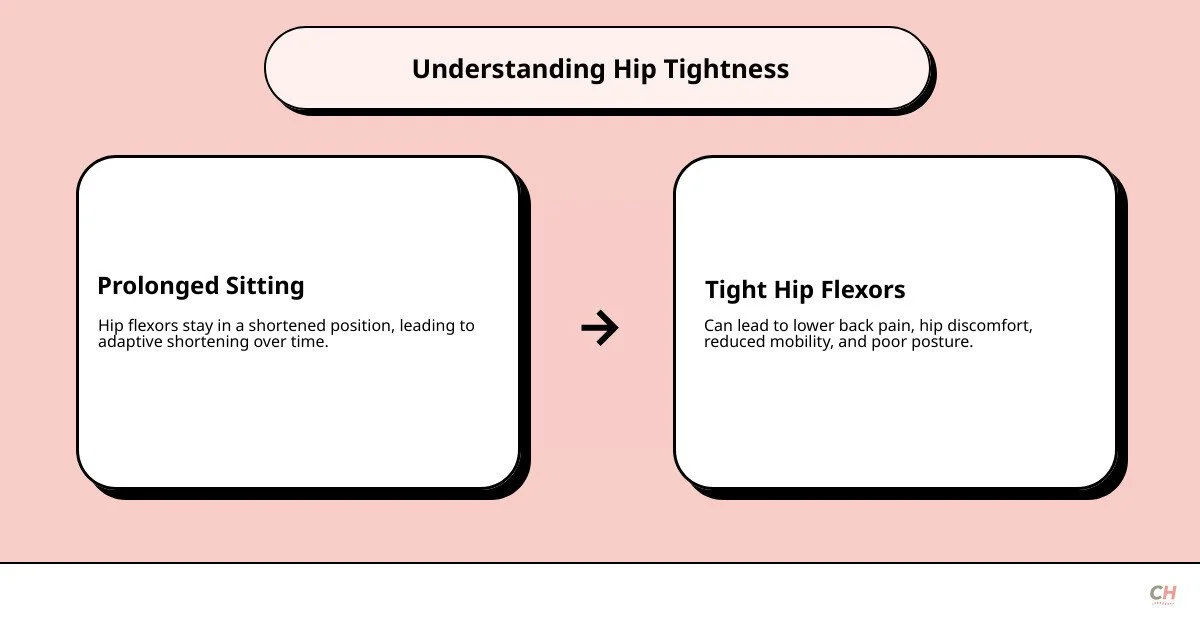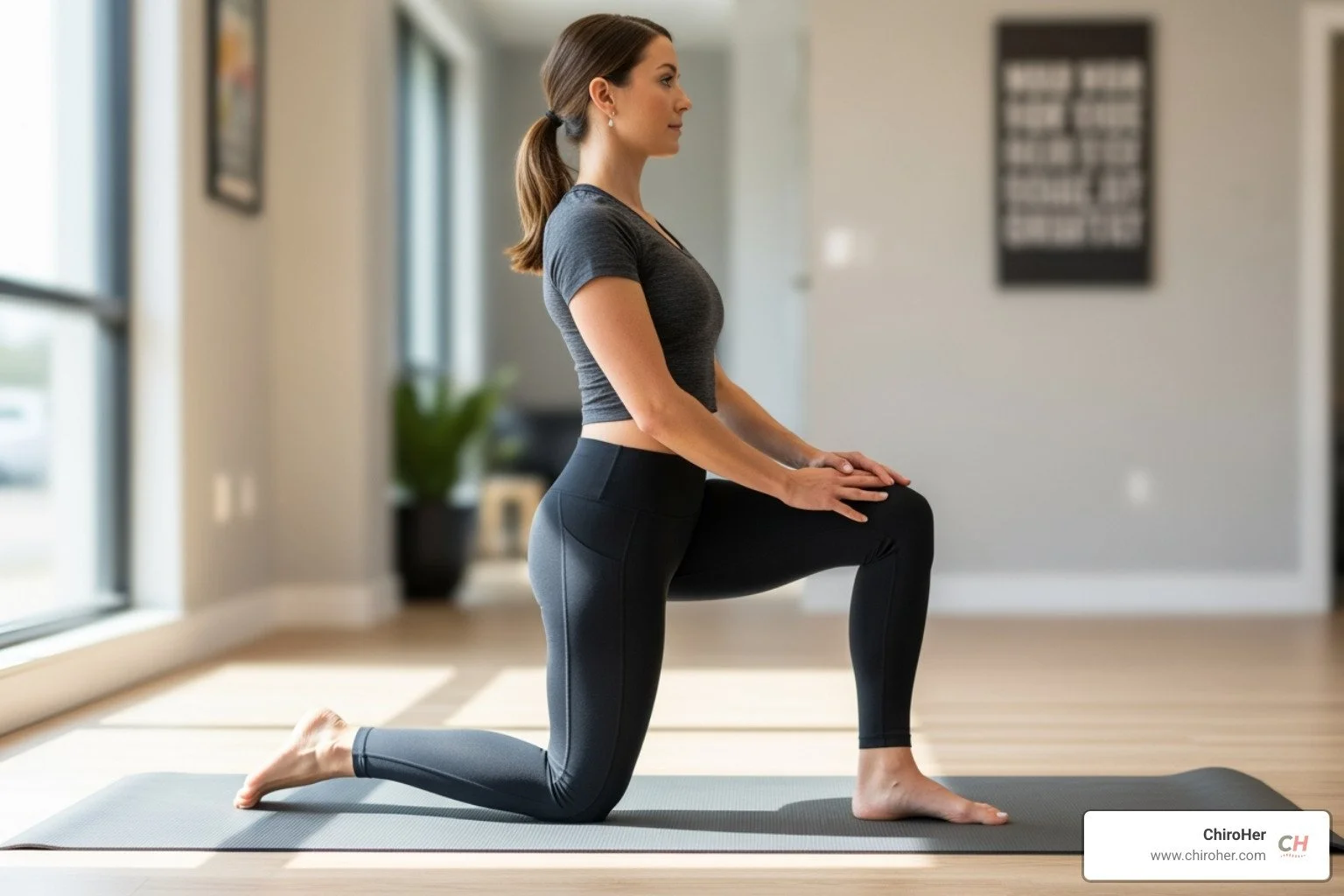Hip Hip Hooray: The Best Stretches for Tight Hips
Why Your Hips Are Tight and How Stretching Can Help
Learning how to stretch hips properly can significantly improve your daily comfort and mobility.
Quick Hip Stretching Guide:
Warm up first - Walk for 5-10 minutes or stretch after a warm shower.
Hold static stretches - Aim for 30-60 seconds each.
Focus on key muscles - Target hip flexors, glutes, and inner thighs.
Be consistent - Stretch 2-3 times per week, or daily if you sit for long periods.
Listen to your body - Stretches should feel good, not hurt.
Your hips might feel tight for several reasons, but prolonged sitting is the biggest culprit. When you sit all day, your hip flexors stay in a shortened position, leading to "adaptive shortening," where muscles become tighter over time.
This tightness in the hip flexors—the muscles at the top of your thighs that help you bend and lift your knees—can lead to:
Lower back pain
Hip discomfort
Reduced mobility
Poor posture
The good news is that regular stretching can help counteract these effects, easing stiffness and reducing the risk of pain.
Hi! I'm Dr. Michelle Andrews, founder of ChiroHer. I've helped hundreds of patients learn how to stretch their hips for pain relief and better mobility. I've seen how proper stretching can greatly improve a person's quality of life.
Understanding Hip Tightness
Your hip flexors are a group of muscles at the top of your thighs, including the iliopsoas and rectus femoris. They are vital for bending at the hips and lifting your knees.
These muscles can get tight for several reasons:
Sedentary Lifestyle: Sitting for long periods keeps hip flexors in a shortened position, causing them to become weaker and tighter. This is the most common cause of hip tightness.
Overuse: Repetitive movements from activities like running or cycling can also lead to tight hip flexors if not balanced with stretching.
Postural Habits: A tipped pelvis or other daily habits can create imbalances that contribute to tightness.
Emotional Stress: Many people hold stress in their hips. Yoga and other practices suggest that hip-opening stretches can help release this tension.
Inactivity-Induced Inflammation: A lack of movement can lead to systemic inflammation, which contributes to muscle stiffness. Scientific research supports this link.
Tight hips can strain surrounding tissues, increasing your risk for injury and causing pain in the groin, lower back, or hamstrings.
The Benefits of Stretching Your Hips
Regular hip stretching offers more than just feeling less stiff; it improves your overall well-being.
Increased Range of Motion: Stretching improves hip mobility, making daily tasks like bending, climbing stairs, and walking easier.
Reduced Back and Hip Pain: Tight hip flexors can pull on the pelvis and misalign the spine, causing lower back pain. Stretching alleviates this tension. We’ve seen how addressing hip alignment can significantly improve back comfort for our patients. For more information about improving pelvic alignment, you can check out our article.
Improved Posture: Flexible, balanced hip flexors help stabilize your torso and maintain good posture.
Better Circulation: Stretching improves blood flow, which promotes healing and reduces inflammation.
Injury Risk Reduction: Regular stretching helps reduce the risk of strains and sprains by allowing your body to move correctly without compensation.
Emotional Release: Many yoga traditions view the hips as a place where stress is stored. Hip-opening stretches can provide a sense of calm and release.
Consistently stretching your hips can lead to less tightness, reduced pain, better mobility, and fewer injuries.
How to Stretch Hips: A Step-by-Step Guide
Learning how to stretch hips effectively starts with two types of stretching: dynamic and static. Dynamic stretches involve gentle movement and are great for warming up. Static stretches involve holding a position to improve flexibility and are best for cooling down.
Always warm up first with a 5-10 minute walk or light movement. Stretching after a warm shower also works well.
Focus on deep breathing to help your muscles relax into each stretch. Never push through pain; a stretch should create a gentle pulling sensation, not sharp discomfort.
Best Static Stretches for Deep Relief
For deep relief, hold these static stretches for 30-60 seconds to allow your muscles to lengthen.
Kneeling Hip Flexor Stretch: Kneel on your left knee (use a cushion for comfort) and place your right foot flat on the floor in front of you, knee bent at 90 degrees. Keeping your back straight and core engaged, gently push your hips forward until you feel a stretch in your left hip. Hold, then switch sides.
Pigeon Pose: From your hands and knees, bring your right knee forward toward your right wrist. Extend your left leg straight back, keeping your hips square. Stay upright or fold forward for a deeper stretch. Use a blanket under your hip for support if needed.
Butterfly Stretch: Sit with the soles of your feet together and let your knees fall out to the sides. Hold your feet, keep your back straight, and gently lean forward from your hips to deepen the stretch in your inner thighs.
For more targeted approaches to hip alignment, check out our hip alignment stretches guide.
Dynamic Movements to Improve Hip Mobility
Use these dynamic, controlled movements as a pre-workout warm-up to increase blood flow and prepare your hips for activity.
Spiderman Lunge: From a high plank, step your right foot to the outside of your right hand. Let your hips sink to feel a stretch in your left hip flexor and right inner thigh. Hold briefly, return to plank, and switch sides. Aim for 5 lunges per leg for 3 sets.
Leg Swings: Holding a wall for balance, swing one leg forward and backward in a controlled arc. Then, face the wall and swing the leg from side to side across your body. Perform 10-15 smooth swings in each direction per leg.
High Knees: Stand with feet hip-width apart and run in place, driving your knees up toward your chest. Keep a quick, rhythmic pace. Do 3 sets of 10 repetitions per side.
Strengthening Exercises for Healthy Hips
Strengthening the muscles around your hips is vital for addressing muscle imbalances and achieving long-term relief. Weak glutes often contribute to hip flexor tightness.
Glute Bridges: Lie on your back with knees bent and feet flat. Press through your heels to lift your hips, forming a straight line from knees to shoulders. Squeeze your glutes at the top, then lower slowly. This also improves core stability.
Clamshells: Lie on your side with knees bent at 45 degrees and heels together. Lift your top knee toward the ceiling without moving your hips. This targets the hip abductors, which are often weak from sitting.
Standing Hip Abduction: Hold a wall for balance and slowly lift one leg out to the side, keeping your toes pointed forward. Lift only as high as you can without tilting your torso, hold for 5 seconds, and lower slowly.
Combining strengthening with stretching creates balanced, healthy hips. If you're dealing with related posture issues, our anterior pelvic tilt exercises can provide more targeted relief.
Your Guide to Safe and Effective Hip Health
Now that you know how to stretch hips, let's cover how to do it safely and when to seek professional help.
Precautions and Best Practices for Hip Stretching
The most important rule is to listen to your body. A stretch should feel like a gentle pull, never sharp pain.
Warm up first: Never stretch cold muscles. A 5-10 minute walk or stretching after a warm shower prepares your body and prevents injury.
Breathe deeply: Deep breaths help your muscles relax and release tension, making your stretches more effective.
Be consistent: Aim for daily stretching if you sit a lot, or at least 2-3 times per week. Consistency is more important than intensity.
Focus on proper form: Correct form is more important than how deep you can stretch. Use props like blocks or blankets for support.
Stay hydrated and balanced: Hydrated muscles are more elastic. Remember to balance stretching with strengthening exercises for your glutes and hamstrings. The Arthritis Foundation offers excellent advice on hip exercises that combine both.
When to Seek Professional Help for Hip Pain
Stretching can be very effective, but it isn't always the only solution for hip pain, which can stem from many issues.
You should see a healthcare professional if you experience:
Persistent pain that lasts more than 6 weeks despite rest and stretching.
Sharp or sudden pain, which could signal an acute injury.
Trouble bearing weight on the affected leg.
Swelling, redness, or warmth around the hip.
Symptoms that worsen with stretching.
Pain accompanied by fever or feeling generally unwell.
At ChiroHer, we specialize in finding the root cause of your hip pain. We perform a thorough assessment to identify the source of your discomfort and create a personalized treatment plan. This may include gentle adjustments, targeted therapies, and specific guidance on stretching.
If you're dealing with persistent hip discomfort, I encourage you to schedule a consultation with us. We're here to help you move freely and live comfortably. For more information about our comprehensive approach, you can learn more about our chiropractic care.
This guide is for informational purposes and is not a substitute for already established medical advice from your healthcare provider.




